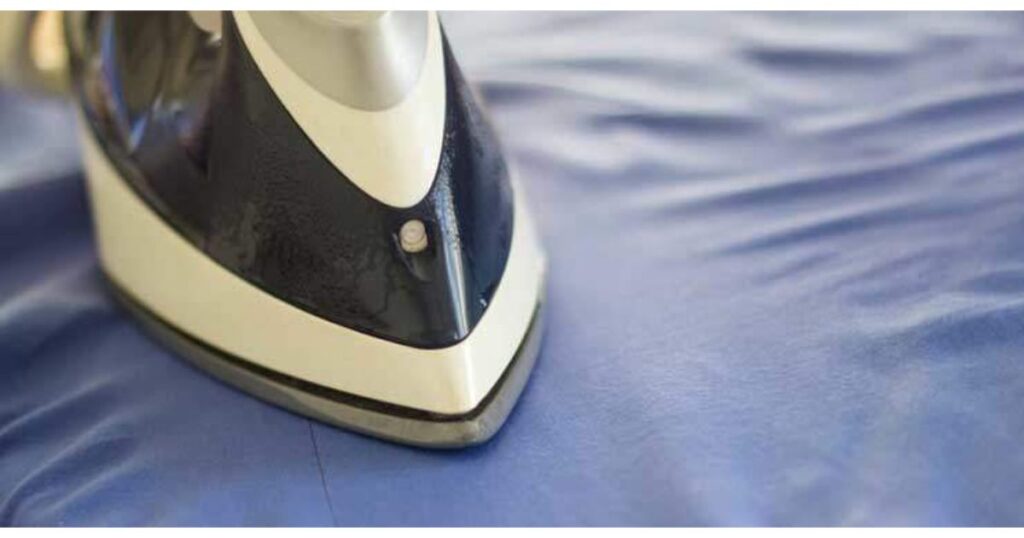If you’ve been putting off ironing your wrinkled polyester shirt or blouse due to fear of burn marks, you’re in good company. But you don’t have to dread this task any longer.
The good news is that ironing polyester doesn’t have to be a hassle. Polyester can be tricky to iron because it’s sensitive to heat and can melt if not handled correctly. This makes it one of the more challenging fabrics to get right.
The trick to ironing polyester is using the correct iron setting, a pressing cloth, and steam. It’s straightforward with these tips.
In our step-by-step guide, we’ll show you how to iron polyester efficiently. By the end, you’ll be able to handle your polyester garments like an expert.
Is Polyester Prone to Wrinkling?

Polyester has a reputation for being a low-maintenance fabric, and for good reason. This synthetic wonder is designed to resist wrinkles, making it a popular choice for everything from business attire to travel clothes.
But why exactly does polyester have this magical ability to stay smooth? The secret lies in the fabric’s structure. Polyester fabrics are made from long-chain polymers that are tightly packed together, creating a strong and resilient material.
This unique composition allows polyester to bounce back from creases and maintain its shape, even after being stuffed in a suitcase or tossed in a laundry basket.
However, while polyester is less prone to wrinkling than natural fibers like cotton or linen, it’s not entirely immune to creases.
How Does Polyester Resist Wrinkling?
The wrinkle-resistant nature of polyester is no accident. It’s the result of clever engineering and some fascinating science. At its core, polyester’s ability to resist wrinkles comes down to three key factors: its polymer structure, high tensile strength, and heat-setting process.
Firstly, the long polymer chains in polyester are arranged in a way that allows them to slide past each other when the fabric is bent or folded. This flexibility means that polyester can easily return to its original shape once the pressure is removed.
Secondly, the high tensile strength of polyester fibers means they can withstand a lot of stress without breaking or becoming permanently deformed.
Finally, during manufacturing, polyester undergoes a heat-setting process that “locks in” its shape at a molecular level, further enhancing its ability to resist wrinkles.
Why Does My Polyester Wrinkle?
Despite its wrinkle-resistant properties, you might find yourself wondering, “Why does my polyester still wrinkle?” The truth is, while polyester is better at resisting wrinkles than many other fabrics, it’s not completely immune.
Several factors can cause your polyester clothes to develop those pesky creases. Understanding these factors is key to caring for polyester effectively and keeping your garments looking their best.
Let’s move into the main culprits behind those unwanted wrinkles in your polyester items.
1. Heat Sensitivity
One of the main reasons polyester can wrinkle is its sensitivity to heat. While polyester is designed to withstand moderate temperatures, exposure to high heat can cause the fabric to lose its shape and develop wrinkles.
This is why ironing polyester correctly is so crucial. When polyester is exposed to excessive heat, the polymer chains that give the fabric its structure can become disrupted.
This disruption can lead to temporary or even permanent deformation of the fabric, resulting in those stubborn wrinkles that seem impossible to remove.
That’s why it’s essential to use the right iron settings for polyester and avoid exposing the fabric to high temperatures for extended periods.
2. Improper care
Another common cause of wrinkles in polyester is improper care. While polyester is generally low-maintenance, it still requires some attention to keep it looking its best. Mishandling your polyester garments can lead to unnecessary wrinkling.
For example, cramming polyester clothes into an overcrowded drawer or hanging them improperly can create creases that are difficult to remove. Similarly, leaving polyester items in a heap after washing or drying can lead to set-in wrinkles.
To avoid these issues, it’s important to follow proper polyester garment care techniques, such as folding items neatly or hanging them correctly after washing and drying.
3. Drying
The way you dry your polyester items can significantly impact their tendency to wrinkle. High heat drying is a common culprit when it comes to creating wrinkles in polyester fabrics.
The intense heat can cause the fibers to contract and twist, leading to creases and wrinkles. To prevent this, it’s best to use a low heat setting when machine drying polyester or, better yet, air dry your items.
If you must use a dryer, remove the items while they’re still slightly damp and hang them to finish drying. This method can help prevent wrinkles and maintain the shape of your polyester garments.
4. Folding
While folding might seem like a harmless way to store your polyester items, it can actually lead to wrinkles if not done properly.
When polyester is folded and left in the same position for an extended period, creases can form along the fold lines. To minimize this issue, try to avoid leaving polyester items folded for long periods.
If you must fold them, consider using tissue paper between the folds to prevent sharp creases. Alternatively, hanging your polyester garments can help prevent fold lines and keep them wrinkle-free.
5. Washing
The washing process can be a major source of wrinkles in polyester clothing. The agitation during the wash cycle, combined with the spinning action, can cause the fabric to twist and crease.
These wrinkles can become more pronounced if the items are left in the washing machine for an extended period after the cycle ends. To minimize washing-related wrinkles, try using a gentle cycle and avoid overloading the machine.
Remove your polyester items promptly after the wash cycle and either hang them to dry or transfer them to the dryer immediately. This can help prevent deep-set wrinkles from forming.
Recommended Blog: Wildskirts: The Ultimate Fashion Statement
Can You Iron Polyester?

The question of whether you can iron polyester is one that often confuses people. The short answer is yes, you can iron polyester but it requires some care and attention.
Ironing polyester fabric is possible and can be very effective in removing wrinkles, but it’s crucial to do it correctly to avoid damaging the fabric. Many people are hesitant to iron polyester due to fears of melting or scorching the fabric.
While these concerns aren’t entirely unfounded, polyester is indeed sensitive to high heat with the right technique and temperature settings, so you can safely and effectively iron your polyester items.
The key is to use a low to medium heat setting and to always check the care label for specific instructions. Some polyester blends may require different care than 100% polyester fabrics.
How to Iron Polyester: Step-by-Step Instructions
Now that we’ve covered the basics of polyester and its relationship with wrinkles, let’s dive into the nitty-gritty of how to iron polyester fabric.
Follow these steps to achieve wrinkle-free polyester garments without damaging the fabric.
Remember, the goal is to remove wrinkles while preserving the integrity of the fabric. With these ironing polyester tips, you’ll be able to tackle even the most stubborn creases with confidence.
1. Set the Right Ironing Temperature
The first and most crucial step in ironing polyester correctly is setting the right temperature. Polyester is sensitive to heat, so using an iron that’s too hot can lead to scorching, melting, or creating a shiny surface on your garment.
Most irons have a specific polyester setting, which is usually on the lower end of the temperature spectrum. If your iron doesn’t have this setting, aim for a low to medium heat.
A good rule of thumb is to start with the lowest heat setting and gradually increase if needed. Always test the iron on an inconspicuous area of the garment first to ensure it doesn’t damage the fabric.
2. Use a Steam Iron
A steam iron can be your best friend when it comes to ironing polyester tips. The steam helps to relax the fibers of the fabric, making it easier to remove wrinkles without applying excessive heat or pressure.
When using a steam iron, hold it slightly above the fabric and let the steam do most of the work. If your iron doesn’t have a steam function, you can create a similar effect by lightly misting the polyester fabric with water before ironing.
Just be careful not to soak the fabric – a light mist is all you need. The combination of moisture and heat can effectively smooth out wrinkles in polyester.
3. Place a Pressing Cloth
Using a pressing cloth is one of the best ironing techniques for polyester. A pressing cloth acts as a barrier between the iron and the polyester fabric, providing an extra layer of protection against heat damage.
You can use a thin cotton cloth or even a clean white cotton handkerchief as a pressing cloth. To use a pressing cloth, simply place it over the area of the polyester garment you’re about to iron.
Then, iron over the pressing cloth rather than directly on the polyester. This method allows you to apply a bit more pressure and heat if needed, without risking damage to the polyester fabric underneath.
Recommended Blog: Signs of Unhealthy Locs: Tips for Dreadlocks Care & Repair
How to Iron Different Polyester Items
Different polyester items may require slightly different approaches when it comes to ironing. Let’s break down the best way to iron polyester for various common items you might encounter in your wardrobe or home.
Remember, regardless of the specific item, always check the care label first and use these tips in conjunction with any specific care instructions provided by the manufacturer. With these techniques, you’ll be able to tackle any polyester item with confidence.
Polyester Curtains
Ironing polyester curtains can seem daunting due to their size, but with the right approach, you can achieve smooth, wrinkle-free window dressings. Start by setting up your ironing board near the curtain rod if possible.
This will allow you to iron the curtains while they’re hanging, which can make the process easier. Use a low heat setting and steam function if available.
Work in sections, starting from the top and moving downwards. For pleated curtains, use a pressing cloth and iron along the pleats to maintain their shape. Remember to let the curtains cool and settle before adjusting their position on the rod.
Polyester Pants
When it comes to ironing polyester pants, the key is to maintain crisp creases while avoiding a shiny surface. Start by turning the pants inside out to protect the outer surface.
Use a low to medium heat setting and a pressing cloth for extra protection. Begin with the waistband and pockets, then move on to the legs. For creases, fold the pants along the desired line and press firmly with the iron.
To avoid creating unwanted creases, use a sliding motion rather than pressing down in one spot. Remember to let the pants cool completely before wearing to help set the creases.
Polyester Dresses and Shirts
Ironing polyester dresses and shirts requires attention to detail, especially around areas like collars, cuffs, and pleats. Start with a low heat setting and use a pressing cloth for added protection. Iron the collar first, working from the points inward. For cuffs, open them flat and iron from the inside out.
When ironing the body of the shirt or dress, start with the sleeves and work your way to the main body. Use gentle, sweeping motions and avoid applying too much pressure.
For pleated areas, iron along the pleats to maintain their shape. Always hang polyester dresses and shirts immediately after ironing to prevent new wrinkles from forming.

